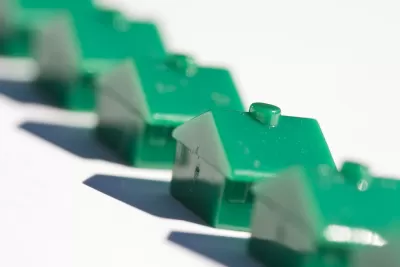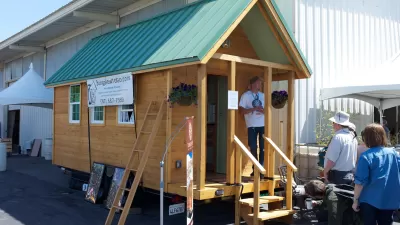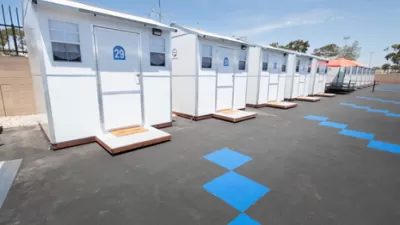While cities like New York and San Francisco consider ways to incentivize the development of micro apartments, a Northeast Washington neighborhood has become home to an experiment in small house production.

In an extreme reversal of America's pre-recession housing tastes, the McMansion seems to be going out of favor while the country's appetite for exceedingly small living spaces in urban areas seems to be growing. The latest incarnation of this trend can be found in the Northeast Washington D.C. neighborhood known as Stronghold, where "a cluster of what neighbors call 'those tiny people, building their tiny houses,' has appeared, reports Emily Wax. "The people aren’t really tiny, but their homes are — 150 to 200 square feet of living space, some with gabled roofs, others with bright cedar walls, compact bathrooms and cozy sleeping lofts that add up to living spaces that are smaller than the walk-in closets in a suburban McMansion."
"The group behind Stronghold’s tiny-house community calls itself Boneyard Studios," writes Wax. “'As property values and rents rise across the city, we want to showcase this potential option for affordable housing,' the group writes on its Web site. 'We decided to live the questions: Can we build and showcase a few tiny homes on wheels in a DC urban alley lot? . . . Not in the woods, but in a true community, connected to a neighborhood? Yes, we think. Watch out left coast, the DC adventure begins.'”
"There’s one problem: The city’s zoning laws don’t allow residential dwellings on alley lots unless they are a minimum of 30 feet wide, or roughly the width of a city street. D.C. is currently discussing lifting the 30-foot restriction. So, as Boneyard Studios continues to advocate more progressive zoning laws, it is using the property to showcase what could be."
FULL STORY: Home, squeezed home: Living in a 200-square-foot space

Manufactured Crisis: Losing the Nation’s Largest Source of Unsubsidized Affordable Housing
Manufactured housing communities have long been an affordable housing option for millions of people living in the U.S., but that affordability is disappearing rapidly. How did we get here?

Americans May Be Stuck — But Why?
Americans are moving a lot less than they once did, and that is a problem. While Yoni Applebaum, in his highly-publicized article Stuck, gets the reasons badly wrong, it's still important to ask: why are we moving so much less than before?

Using Old Oil and Gas Wells for Green Energy Storage
Penn State researchers have found that repurposing abandoned oil and gas wells for geothermal-assisted compressed-air energy storage can boost efficiency, reduce environmental risks, and support clean energy and job transitions.

Minneapolis Bans Rent-Setting Software
Four cities have enacted restrictions on algorithmic software that can inflate rent costs.

Oakland to Add 244 New EV Chargers
Oakland plans to launch its new charging network at eight locations by the end of 2025.

Jane Goodall Inspires with Message of Hope, Resilience, and Environmental Action
Speaking in Pasadena, Jane Goodall offered a hopeful and inspirational message, urging global compassion, environmental responsibility, and the power of individual action to shape a better future.
Urban Design for Planners 1: Software Tools
This six-course series explores essential urban design concepts using open source software and equips planners with the tools they need to participate fully in the urban design process.
Planning for Universal Design
Learn the tools for implementing Universal Design in planning regulations.
Heyer Gruel & Associates PA
City of Moreno Valley
Institute for Housing and Urban Development Studies (IHS)
City of Grandview
Harvard GSD Executive Education
Salt Lake City
NYU Wagner Graduate School of Public Service
City of Cambridge, Maryland





























